
The Waffen-SS was the combat branch of the Nazi Party's paramilitary Schutzstaffel (SS) organisation. Its formations included men from Nazi Germany, along with volunteers and conscripts from both German-occupied Europe and unoccupied lands. It was disbanded in May 1945.

The 33rd Infantry Division was a German Army infantry division active in World War II. It served in the battle of France and subsequently was converted into the 15th Panzer Division.

Wilhelm Bittrich was a high-ranking Waffen-SS commander of Nazi Germany. Between August 1942 and February 1943, Bittrich commanded the SS Cavalry Division Florian Geyer, in rear security operations in the Soviet Union. From July 1944 until the end of the war Bittrich commanded the 2nd SS Panzer Corps in Normandy, during Market Garden and in Hungary.
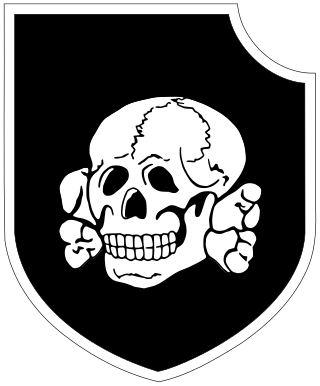
The 3rd SS Panzer Division "Totenkopf" was an elite division of the Waffen-SS of Nazi Germany during World War II, formed from the Standarten of the SS-TV. Its name, Totenkopf, is German for "death's head" – the skull and crossbones symbol – and it is thus sometimes referred to as the Death's Head Division.
The IX Waffen Mountain Corps of the SS (Croatian) (German: IX. Waffen-Gebirgskorps der SS (Kroatisches)), later simply IX SS Mountain Corps, was a Waffen-SS corps during World War II. Originally set up to command Croatian and Albanian SS divisions, it also commanded a variety of other German and Hungarian units of the Waffen-SS. It saw action on the Eastern Front between July 1944 and January 1945 when it was virtually destroyed during the Siege of Budapest.

The 22nd SS Volunteer Cavalry Division was a German Waffen-SS cavalry division which was active on the Eastern Front during World War II. The division was composed primarily of Royal Hungarian Army Volksdeutsche conscripts who were transferred to the Waffen-SS following an agreement between Germany and Hungary. The division is commonly known under the Maria Theresia name in publications, although no documents have been found to confirm this name.
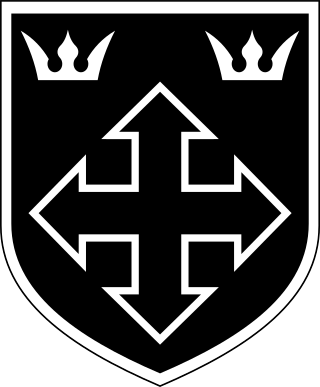
The 25th Waffen Grenadier Division of the SS "Hunyadi" was a short-lived infantry division of the Waffen-SS, an armed branch of the German Nazi Party that served alongside but was never formally part of the Wehrmacht during World War II. Established in November 1944 following the German overthrow of the Hungarian regime of Miklós Horthy, it consisted mainly of troops drawn from the Royal Hungarian Army's 13th Honvéd Division. It was never properly formed, trained, or equipped, and after being evacuated from its training camp in the face of the advancing Soviet Red Army, it surrendered to the United States Army in Austria in May 1945.
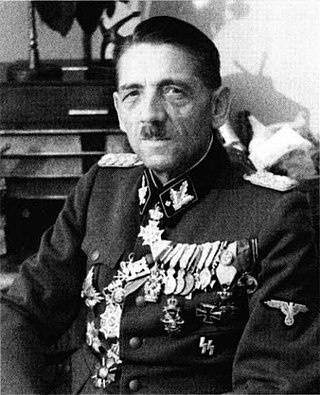
Artur Gustav Martin Phleps was an Austro-Hungarian, Romanian and Nazi German army officer who held the rank of SS-Obergruppenführer und General der Waffen-SS in the Waffen-SS during World War II. An Austro-Hungarian Army officer before and during World War I, Phleps specialised in mountain warfare and logistics, and had been promoted to Oberstleutnant by the end of the war. During the interwar period he joined the Romanian Army, reaching the rank of General de divizie, and also became an adviser to King Carol. After he spoke out against the government, he was sidelined and asked to be dismissed from the army.

The XV SS Cossack Cavalry Corps was a World War II cavalry corps of the Waffen-SS, the armed wing of the German Nazi Party, primarily recruited from Cossacks.

The 1st Cossack Cavalry Division was a Cossack division of the German Army that served during World War II. It was created on the Eastern Front mostly with Don Cossacks already serving in the Wehrmacht, those who escaped from the advancing Red Army and Soviet POWs. In 1944, the division was transferred to the Waffen SS, becoming part of the XV SS Cossack Cavalry Corps, established in February 1945. At the end of the war, the unit ceased to exist.

The 23rd Waffen Mountain Division of the SS Kama was a German mountain infantry division of the Waffen-SS, the armed wing of the German Nazi Party that served alongside but was never formally part of the Wehrmacht during World War II. At the post-war Nuremberg trials, the Waffen-SS was declared to be a criminal organisation due to its major involvement in war crimes and crimes against humanity. The division was composed of German officers and Bosnian Muslim soldiers. Named Kama after a small dagger used by Balkan shepherds, it was one of the thirty-eight divisions fielded by the Waffen-SS during World War II. Formed on 19 June 1944, it was built around a cadre from the 13th Waffen Mountain Division of the SS Handschar but did not reach its full strength and never saw action as a formation.
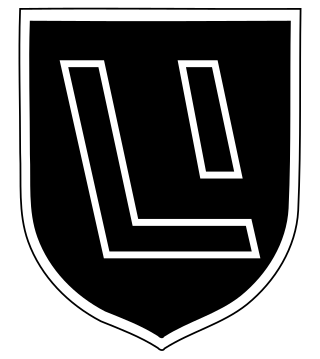
The 15th Waffen Grenadier Division of the SS , originally called the Latvian SS-Volunteer Division was an infantry division of the Waffen-SS during World War II. It was formed in February 1943, and together with its sister unit, the 19th Waffen Grenadier Division of the SS formed the Latvian Legion.

The 8th SS Cavalry Division "Florian Geyer" was a German Waffen-SS cavalry division during World War II. It was formed in 1942 from a cadre of the SS Cavalry Brigade which was involved in the Bandenbekämpfung ("bandit-fighting") operations behind the front line and was responsible for the killing of tens of thousands of the civilian population. It continued "pacification" operations in the occupied Soviet Union, leading to further atrocities.

37th SS Volunteer Cavalry Division "Lützow" was a German Cavalry division of the Waffen-SS during the Second World War. It was formed in February 1945 from the personnel and equipment of the 8th SS Cavalry Division and the 22nd SS Volunteer Cavalry Division. In addition to this, many under-age German, Hungarian and 'Volksdeutsche' helped make up the division. The division was intended to have three cavalry regiments comprising two battalions each, however, due to the inadequate amount of men and equipment it could only field two understrength regiments as its main combat units. The division was initially commanded by SS-Oberführer Waldemar Fegelein until March when he was replaced by SS-Standartenführer Karl Gesele. The unit saw action against the Soviets as a part of the 6th Panzer Army during the final weeks of the war, before surrendering to Americans in Austria in May 1945. It was named after the Prussian general Adolf von Lützow.
33rd Division or 33rd Infantry Division may refer to:
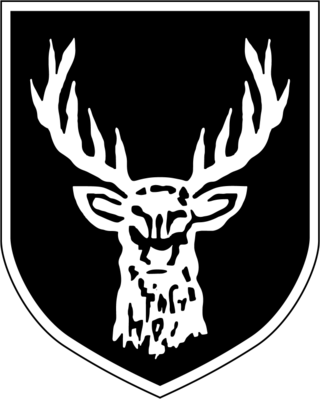
The 31st SS Volunteer Grenadier Division was a German infantry division of the Waffen-SS during the Second World War, commanded by SS-Brigadeführer, Gustav Lombard. The division was formed of German, Hungarian, Serbian and other Volksdeutsche, mostly from the Batschka region as well as the personnel and equipment from the 23rd Waffen Mountain Division SS 'Kama'. By 26 October 1944, Army Group South deployed the division to the frontlines to assist in securing the Danube, despite its complete lack of heavy weapons, inadequate training and weaponry. During the division’s stay in Lower Styria, an order from 16 January 1945 reorganised the division from a Type 1944 division into a Type 1945 division. A month later on 17 February 1945, orders were given for the immediate transfer of the division to Silesia in the Görlitz area in preparation for an upcoming offensive operation. Portions of the division were still under the 17th Army's command in the Hirschberg region, incorporated into their order of battle as army reservists.

Eugène Vaulot was a Frenchman with the rank of Unterscharführer in the Waffen-SS during World War II, who was awarded the Knight's Cross of the Iron Cross.
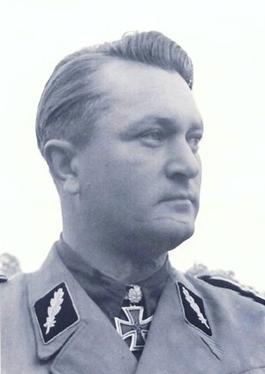
Karl Ullrich was the last commander of the SS Division Wiking in the Waffen-SS during World War II. After the war he authored an account of the SS Division Totenkopf.
The I Cavalry Corps, initially known simply as the Cavalry Corps, or alternatively as Cavalry Corps Harteneck after its commander, was an army corps of the German Wehrmacht during World War II. It was formed in 1944 and existed until 1945.
















